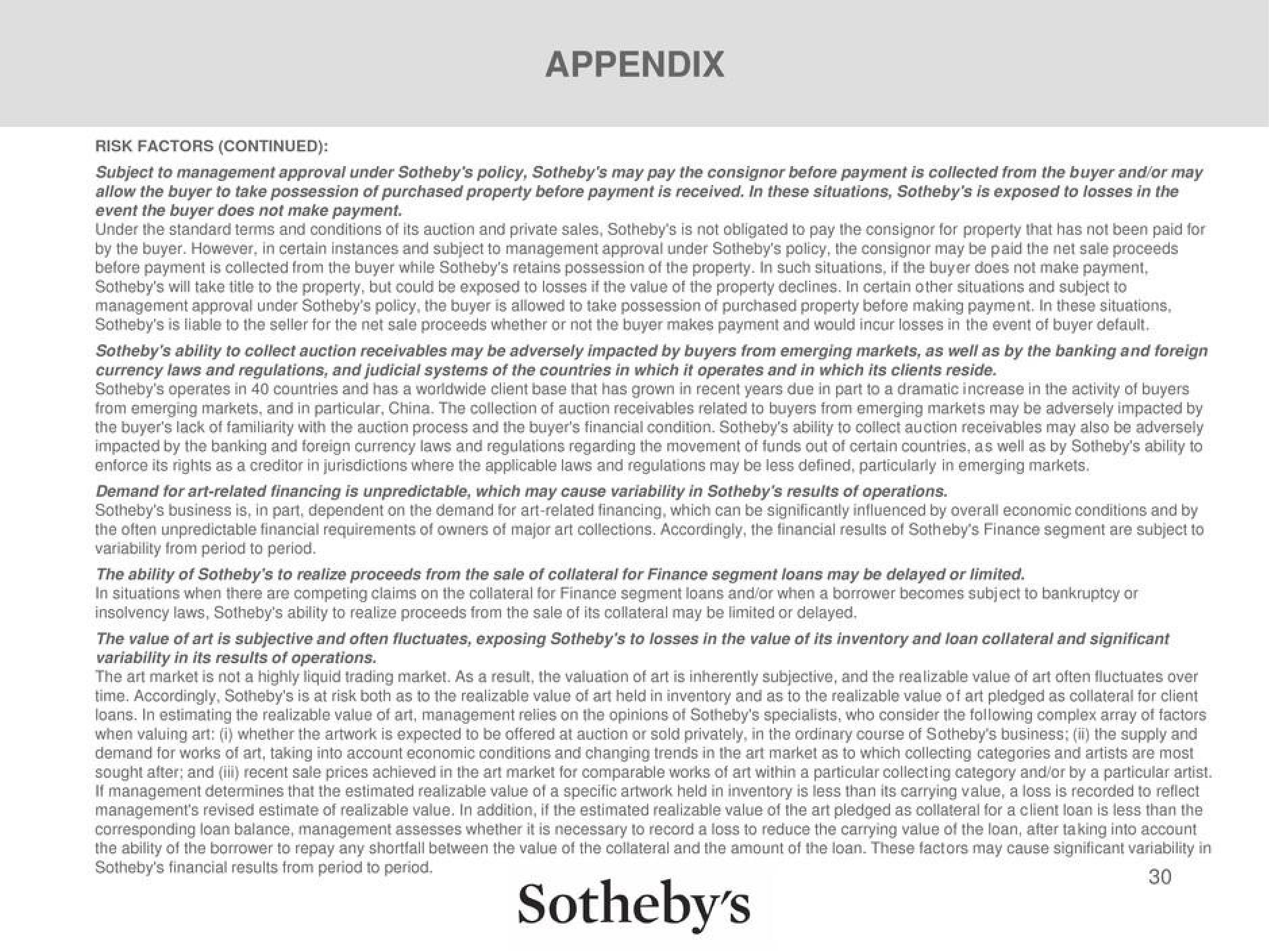Sotheby's Investor Briefing
APPENDIX
RISK FACTORS (CONTINUED):
Subject to management approval under Sotheby's policy, Sotheby's may pay the consignor before payment is collected from the buyer and/or may
allow the buyer to take possession of purchased property before payment is received. In these situations, Sotheby's is exposed to losses in the
event the buyer does not make payment.
Under the standard terms and conditions of its auction and private sales, Sotheby's is not obligated to pay the consignor for property that has not been paid for
by the buyer. However, in certain instances and subject to management approval under Sotheby's policy, the consignor may be paid the net sale proceeds
before payment is collected from the buyer while Sotheby's retains possession of the property. In such situations, if the buyer does not make payment,
Sotheby's will take title to the property, but could be exposed to losses if the value of the property declines. In certain other situations and subject to
management approval under Sotheby's policy, the buyer is allowed to take possession of purchased property before making payment. In these situations,
Sotheby's is liable to the seller for the net sale proceeds whether or not the buyer makes payment and would incur losses in the event of buyer default.
Sotheby's ability to collect auction receivables may be adversely impacted by buyers from emerging markets, as well as by the banking and foreign
currency laws and regulations, and judicial systems of the countries in which it operates and in which its clients reside.
Sotheby's operates in 40 countries and has a worldwide client base that has grown in recent years due in part to a dramatic increase in the activity of buyers
from emerging markets, and in particular, China. The collection of auction receivables related to buyers from emerging markets may be adversely impacted by
the buyer's lack of familiarity with the auction process and the buyer's financial condition. Sotheby's ability to collect auction receivables may also be adversely
impacted by the banking and foreign currency laws and regulations regarding the movement of funds out of certain countries, as well as by Sotheby's ability to
enforce its rights as a creditor in jurisdictions where the applicable laws and regulations may be less defined, particularly in emerging markets.
Demand for art-related financing is unpredictable, which may cause variability in Sotheby's results of operations.
Sotheby's business is, in part, dependent on the demand for art-related financing, which can be significantly influenced by overall economic conditions and by
the often unpredictable financial requirements of owners of major art collections. Accordingly, the financial results of Sotheby's Finance segment are subject to
variability from period to period.
The ability of Sotheby's to realize proceeds from the sale of collateral for Finance segment loans may be delayed or limited.
In situations when there are competing claims on the collateral for Finance segment loans and/or when a borrower becomes subject to bankruptcy or
insolvency laws, Sotheby's ability to realize proceeds from the sale of its collateral may be limited or delayed.
The value of art is subjective and often fluctuates, exposing Sotheby's to losses in the value of its inventory and loan collateral and significant
variability in its results of operations.
The art market is not a highly liquid trading market. As a result, the valuation of art is inherently subjective, and the realizable value of art often fluctuates over
time. Accordingly, Sotheby's is at risk both as to the realizable value of art held in inventory and as to the realizable value of art pledged as collateral for client
loans. In estimating the realizable value of art, management relies on the opinions of Sotheby's specialists, who consider the following complex array of factors
when valuing art: (i) whether the artwork is expected to be offered at auction or sold privately, in the ordinary course of Sotheby's business; (ii) the supply and
demand for works of art, taking into account economic conditions and changing trends in the art market as to which collecting categories and artists are most
sought after; and (iii) recent sale prices achieved in the art market for comparable works of art within a particular collecting category and/or by a particular artist.
If management determines that the estimated realizable value of a specific artwork held in inventory is less than its carrying value, a loss is recorded to reflect
management's revised estimate of realizable value. In addition, if the estimated realizable value of the art pledged as collateral for a client loan is less than the
corresponding loan balance, management assesses whether it is necessary to record a loss to reduce the carrying value of the loan, after taking into account
the ability of the borrower to repay any shortfall between the value of the collateral and the amount of the loan. These factors may cause significant variability in
Sotheby's financial results from period to period.
30
Sotheby'sView entire presentation